Ginger is a hardy herbaceous plant which grows from a rhizome to about 1.5 meters in height. Its evergreen leaves are lanceolate (spear-shaped) and the flowers, in terminal spikes, are a yellowish-white with touches of red. The usable part is, of course, the rhizome which is a spice that is very much a part of Asian cuisines. In the West, it is used in drinks like ginger ale or ginger beer and in sweets like gingerbread.
In Laos, ginger is one of the main culinary spices, although many Lao cooks consider it to be a Chinese spice rather than their own. They often choose instead another Zingiberaceae, galangal, known as kha in Lao, as it is not as strong as ginger. However, in many ethnicities, like the Hmong people, it is the main spice along with chilli, according to Lemoine. It should be noted that in the markets, there are many varieties of ginger, particularly khing noy and khing nyae (small ginger and big ginger). The first is more aromatic than the second. When selecting this spice, you should pay attention to the age of the plant as young gingers are juicy and fleshy with a mild taste but as they grow older, they become fibrous with a sharp, even irritating flavour.
Also in Laos, you will see ginger being used in the same way as in neighbouring countries. Vietnamese use it to make jam and pickled ginger (gari) is used by Japanese people to refresh the palate when eating sushi.
In all these countries, as in Laos, ginger is considered a ‘hot’ plant, an aphrodisiac and a powerful plant whose magic and medicinal properties are often confused, both literally and figuratively. When it is used for magic or medicinal purposes, ginger in Laos is given a special name, which is van, a name given to many plants of which the roots, tubers and rhizomes are used by sorcerers and healers. These are van phai, van kè van, van son, which are not botanical but magical plants.
Ritual uses of ginger range from a simple tea made with the rhizome as an offering to the ancestors among the Akha people (nectar) to magic objects used by a shaman as part of an exorcism or to ritually kill a bad spirit.
Le gingembre est une plante vivace herbacée d’environ 1,50 m de haut issue d’un rhizome. Les feuilles persistantes sont lancéolées, les fleurs en épis terminaux sont d’un blanc jaunâtre ponctué de rouge. La partie la plus utilisée est bien entendu le rhizome qui constitue une épice très employée dans un grand nombre de cuisines asiatiques. En Occident, il entre dans la confection de bières comme la ginger ale ou la ginger beer et de desserts comme le pain d’épices.
Au Laos le gingembre est considéré comme une épice majeure, même si les cuisinières pensent qu’il est la marque de la cuisine chinoise bien plus que de la leur. Elles lui préfèrent souvent une autre Zingibéracée, le galanga, kha en lao, comme étant moins fort que le gingembre. Cependant, dans beaucoup d’ethnies le gingembre est très utilisé comme chez les Hmong dont, nous dit Lemoine, c’est l’épice principale avec le piment. Il faut savoir qu’il y a sur les marchés plusieurs variétés de gingembre, en particulier khing noy et khing nyae, le petit gingembre et le grand gingembre, le premier étant plus parfumé que le second. Lorsque l’on choisit cette épice on doit tenir compte également de l’âge de la plante, en effet les jeunes rhizomes de gingembre sont juteux et charnus avec un goût très doux, mais en vieillissant ils deviennent fibreux avec une saveur forte et irritante.
On connaît aussi au Laos les utilisations que font les voisins asiatiques de cette plante : le gingembre confit des Vietnamiens, le gingembre mariné (gari) des Japonais utilisé pour rafraîchir le palais dans la dégustation de sushi.
Dans tous ces pays, comme au Laos, le gingembre a la réputation d’être une plante chaude, une plante aphrodisiaque, une plante forte au propre comme au figuré dont les vertus magiques et médicinales se confondent. Quand il est utilisé à des fins magico-médicinales le gingembre prend en lao un nom particulier, on l’appelle van, nom donné à plusieurs plantes dont les racines, tubercules ou rhizomes sont utilisés par les sorciers et les guérisseurs. On aura ainsi van phai, van kè van, van son qui ne correspondent plus à des catégories botaniques, mais magiques.
Les utilisations rituelles du gingembre vont du simple thé fait avec son rhizome comme offrande aux ancêtres chez les Akha (boisson de plaisir), à l’objet magique manipulé par le médium, en passant par l’exorcisme ou la mort rituelle de l’esprit malfaisant.
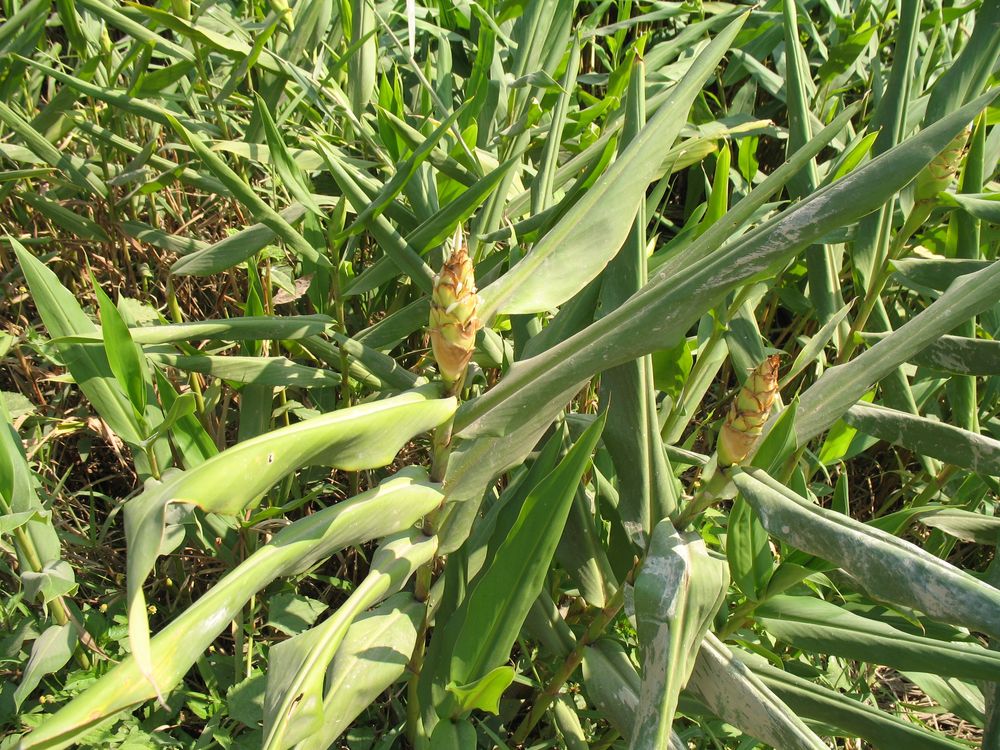
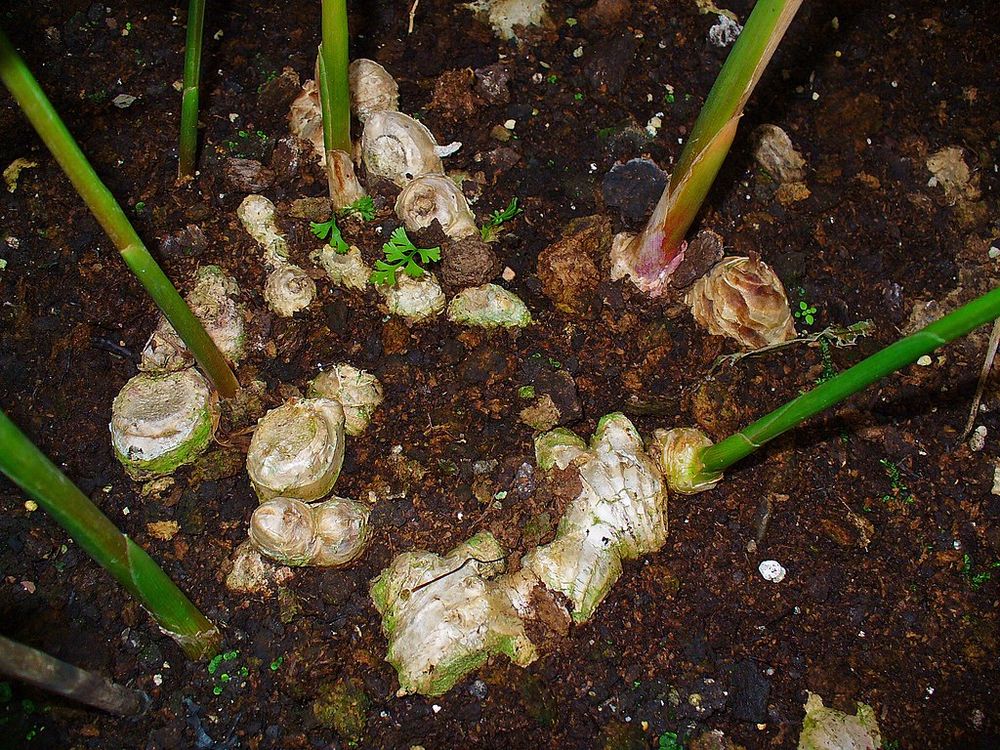
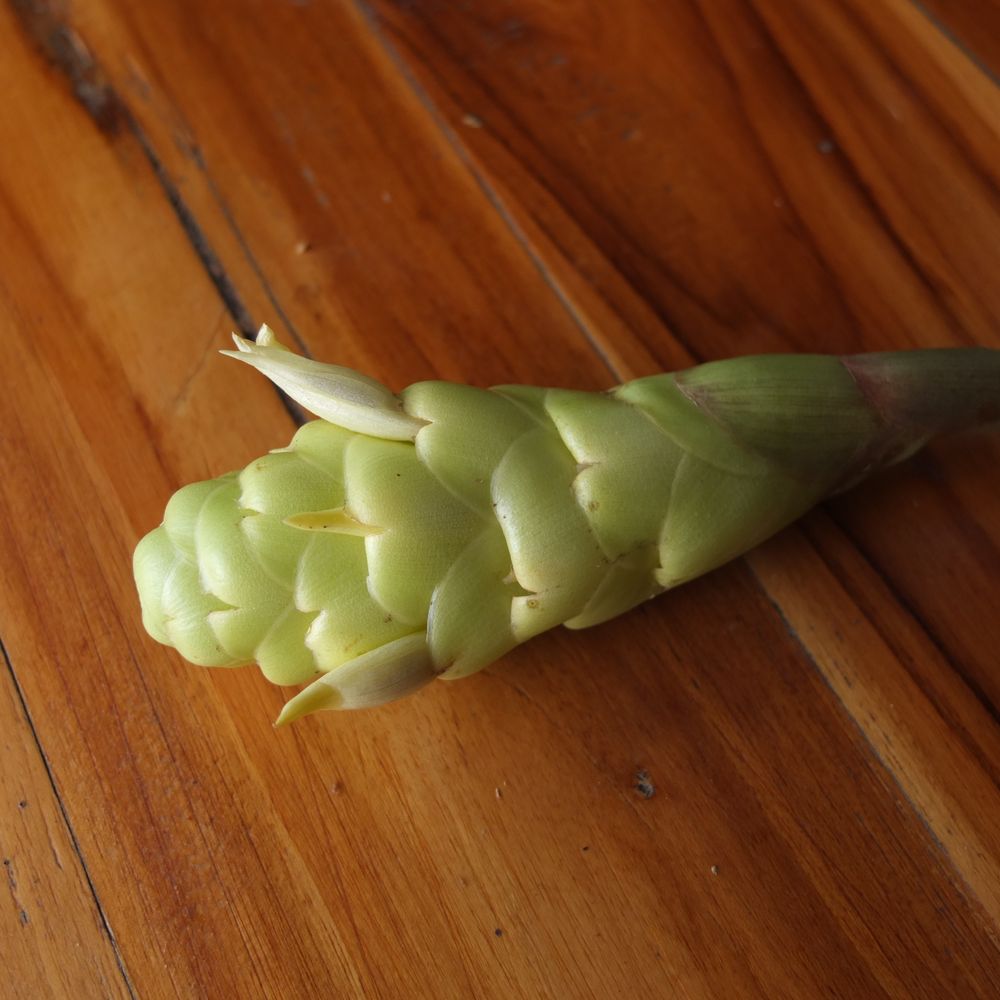
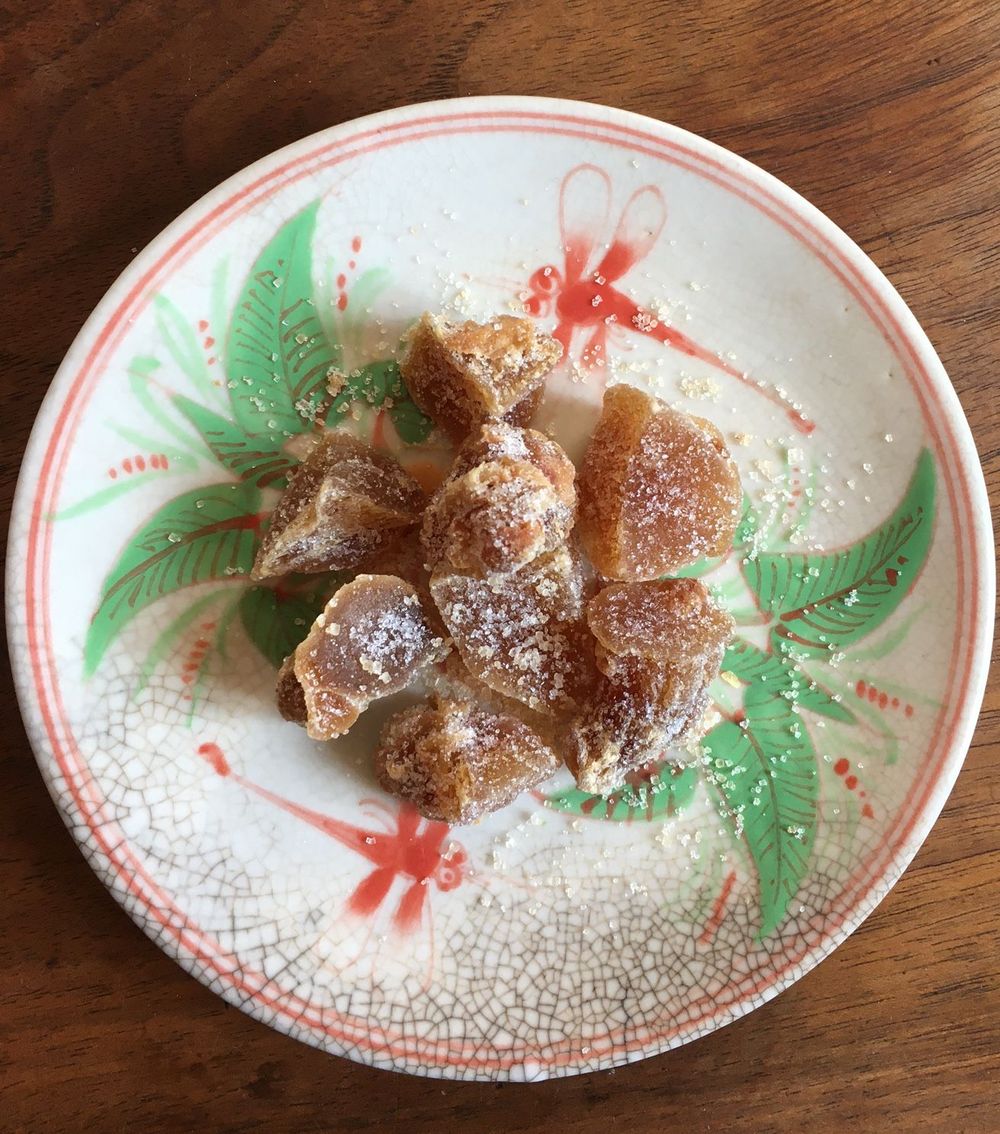
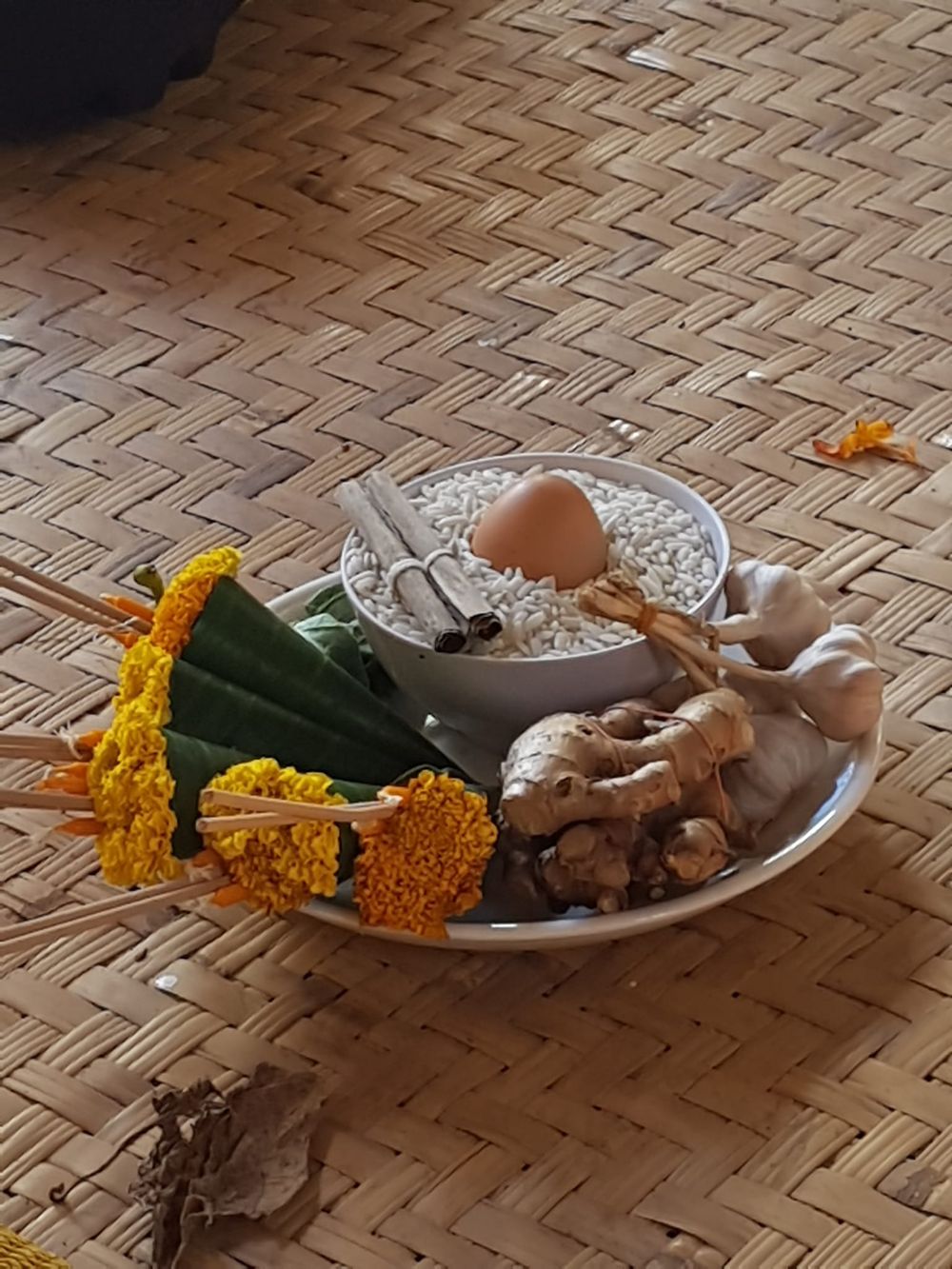
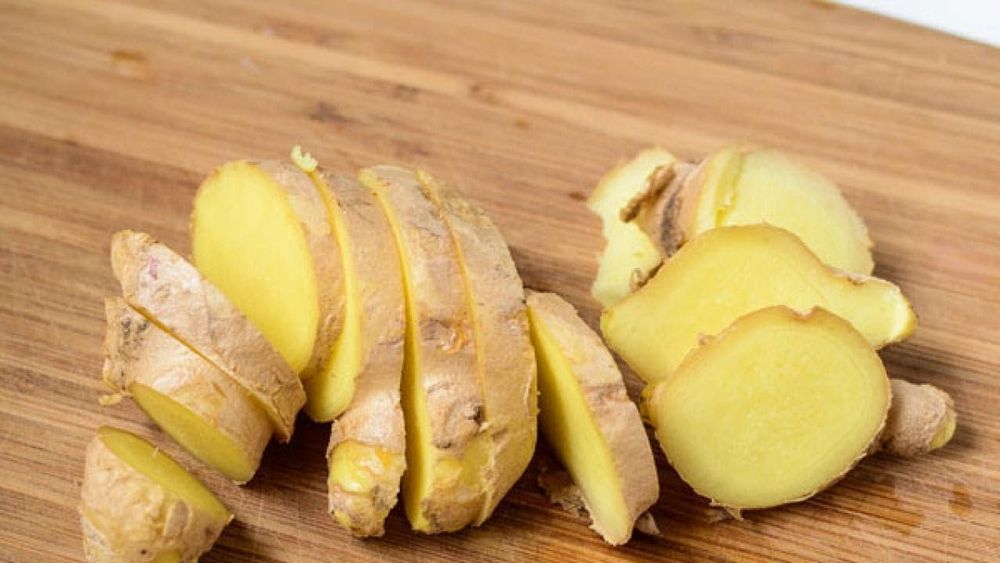
Ginger is a hardy herbaceous plant which grows from a rhizome to about 1.5 meters in height. Its evergreen leaves are lanceolate (spear-shaped) and the flowers, in terminal spikes, are a yellowish-white with touches of red. The usable part is, of course, the rhizome which is a spice that is very much a part of Asian cuisines. In the West, it is used in drinks like ginger ale or ginger beer and in sweets like gingerbread.
In Laos, ginger is one of the main culinary spices, although many Lao cooks consider it to be a Chinese spice rather than their own. They often choose instead another Zingiberaceae, galangal, known as kha in Lao, as it is not as strong as ginger. However, in many ethnicities, like the Hmong people, it is the main spice along with chilli, according to Lemoine. It should be noted that in the markets, there are many varieties of ginger, particularly khing noy and khing nyae (small ginger and big ginger). The first is more aromatic than the second. When selecting this spice, you should pay attention to the age of the plant as young gingers are juicy and fleshy with a mild taste but as they grow older, they become fibrous with a sharp, even irritating flavour.
Also in Laos, you will see ginger being used in the same way as in neighbouring countries. Vietnamese use it to make jam and pickled ginger (gari) is used by Japanese people to refresh the palate when eating sushi.
In all these countries, as in Laos, ginger is considered a ‘hot’ plant, an aphrodisiac and a powerful plant whose magic and medicinal properties are often confused, both literally and figuratively. When it is used for magic or medicinal purposes, ginger in Laos is given a special name, which is van, a name given to many plants of which the roots, tubers and rhizomes are used by sorcerers and healers. These are van phai, van kè van, van son, which are not botanical but magical plants.
Ritual uses of ginger range from a simple tea made with the rhizome as an offering to the ancestors among the Akha people (nectar) to magic objects used by a shaman as part of an exorcism or to ritually kill a bad spirit.
Le gingembre est une plante vivace herbacée d’environ 1,50 m de haut issue d’un rhizome. Les feuilles persistantes sont lancéolées, les fleurs en épis terminaux sont d’un blanc jaunâtre ponctué de rouge. La partie la plus utilisée est bien entendu le rhizome qui constitue une épice très employée dans un grand nombre de cuisines asiatiques. En Occident, il entre dans la confection de bières comme la ginger ale ou la ginger beer et de desserts comme le pain d’épices.
Au Laos le gingembre est considéré comme une épice majeure, même si les cuisinières pensent qu’il est la marque de la cuisine chinoise bien plus que de la leur. Elles lui préfèrent souvent une autre Zingibéracée, le galanga, kha en lao, comme étant moins fort que le gingembre. Cependant, dans beaucoup d’ethnies le gingembre est très utilisé comme chez les Hmong dont, nous dit Lemoine, c’est l’épice principale avec le piment. Il faut savoir qu’il y a sur les marchés plusieurs variétés de gingembre, en particulier khing noy et khing nyae, le petit gingembre et le grand gingembre, le premier étant plus parfumé que le second. Lorsque l’on choisit cette épice on doit tenir compte également de l’âge de la plante, en effet les jeunes rhizomes de gingembre sont juteux et charnus avec un goût très doux, mais en vieillissant ils deviennent fibreux avec une saveur forte et irritante.
On connaît aussi au Laos les utilisations que font les voisins asiatiques de cette plante : le gingembre confit des Vietnamiens, le gingembre mariné (gari) des Japonais utilisé pour rafraîchir le palais dans la dégustation de sushi.
Dans tous ces pays, comme au Laos, le gingembre a la réputation d’être une plante chaude, une plante aphrodisiaque, une plante forte au propre comme au figuré dont les vertus magiques et médicinales se confondent. Quand il est utilisé à des fins magico-médicinales le gingembre prend en lao un nom particulier, on l’appelle van, nom donné à plusieurs plantes dont les racines, tubercules ou rhizomes sont utilisés par les sorciers et les guérisseurs. On aura ainsi van phai, van kè van, van son qui ne correspondent plus à des catégories botaniques, mais magiques.
Les utilisations rituelles du gingembre vont du simple thé fait avec son rhizome comme offrande aux ancêtres chez les Akha (boisson de plaisir), à l’objet magique manipulé par le médium, en passant par l’exorcisme ou la mort rituelle de l’esprit malfaisant.












Ginger is a hardy herbaceous plant which grows from a rhizome to about 1.5 meters in height. Its evergreen leaves are lanceolate (spear-shaped) and the flowers, in terminal spikes, are a yellowish-white with touches of red. The usable part is, of course, the rhizome which is a spice that is very much a part of Asian cuisines. In the West, it is used in drinks like ginger ale or ginger beer and in sweets like gingerbread.
In Laos, ginger is one of the main culinary spices, although many Lao cooks consider it to be a Chinese spice rather than their own. They often choose instead another Zingiberaceae, galangal, known as kha in Lao, as it is not as strong as ginger. However, in many ethnicities, like the Hmong people, it is the main spice along with chilli, according to Lemoine. It should be noted that in the markets, there are many varieties of ginger, particularly khing noy and khing nyae (small ginger and big ginger). The first is more aromatic than the second. When selecting this spice, you should pay attention to the age of the plant as young gingers are juicy and fleshy with a mild taste but as they grow older, they become fibrous with a sharp, even irritating flavour.
Also in Laos, you will see ginger being used in the same way as in neighbouring countries. Vietnamese use it to make jam and pickled ginger (gari) is used by Japanese people to refresh the palate when eating sushi.
In all these countries, as in Laos, ginger is considered a ‘hot’ plant, an aphrodisiac and a powerful plant whose magic and medicinal properties are often confused, both literally and figuratively. When it is used for magic or medicinal purposes, ginger in Laos is given a special name, which is van, a name given to many plants of which the roots, tubers and rhizomes are used by sorcerers and healers. These are van phai, van kè van, van son, which are not botanical but magical plants.
Ritual uses of ginger range from a simple tea made with the rhizome as an offering to the ancestors among the Akha people (nectar) to magic objects used by a shaman as part of an exorcism or to ritually kill a bad spirit.
Le gingembre est une plante vivace herbacée d’environ 1,50 m de haut issue d’un rhizome. Les feuilles persistantes sont lancéolées, les fleurs en épis terminaux sont d’un blanc jaunâtre ponctué de rouge. La partie la plus utilisée est bien entendu le rhizome qui constitue une épice très employée dans un grand nombre de cuisines asiatiques. En Occident, il entre dans la confection de bières comme la ginger ale ou la ginger beer et de desserts comme le pain d’épices.
Au Laos le gingembre est considéré comme une épice majeure, même si les cuisinières pensent qu’il est la marque de la cuisine chinoise bien plus que de la leur. Elles lui préfèrent souvent une autre Zingibéracée, le galanga, kha en lao, comme étant moins fort que le gingembre. Cependant, dans beaucoup d’ethnies le gingembre est très utilisé comme chez les Hmong dont, nous dit Lemoine, c’est l’épice principale avec le piment. Il faut savoir qu’il y a sur les marchés plusieurs variétés de gingembre, en particulier khing noy et khing nyae, le petit gingembre et le grand gingembre, le premier étant plus parfumé que le second. Lorsque l’on choisit cette épice on doit tenir compte également de l’âge de la plante, en effet les jeunes rhizomes de gingembre sont juteux et charnus avec un goût très doux, mais en vieillissant ils deviennent fibreux avec une saveur forte et irritante.
On connaît aussi au Laos les utilisations que font les voisins asiatiques de cette plante : le gingembre confit des Vietnamiens, le gingembre mariné (gari) des Japonais utilisé pour rafraîchir le palais dans la dégustation de sushi.
Dans tous ces pays, comme au Laos, le gingembre a la réputation d’être une plante chaude, une plante aphrodisiaque, une plante forte au propre comme au figuré dont les vertus magiques et médicinales se confondent. Quand il est utilisé à des fins magico-médicinales le gingembre prend en lao un nom particulier, on l’appelle van, nom donné à plusieurs plantes dont les racines, tubercules ou rhizomes sont utilisés par les sorciers et les guérisseurs. On aura ainsi van phai, van kè van, van son qui ne correspondent plus à des catégories botaniques, mais magiques.
Les utilisations rituelles du gingembre vont du simple thé fait avec son rhizome comme offrande aux ancêtres chez les Akha (boisson de plaisir), à l’objet magique manipulé par le médium, en passant par l’exorcisme ou la mort rituelle de l’esprit malfaisant.


